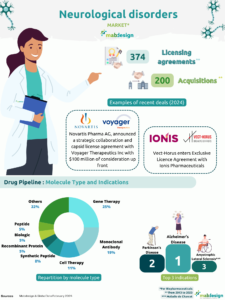Long considered as cellular debris with no biological function, exosomes, and more generally extracellular vesicles (EVs), are now recognized as vectors of biological material with a role in intercellular communication. The building of knowledge on the subject has not only highlighted their role in certain pathologies, but also revealed their potential as biomarkers and therapeutic tools.
Definition and biogenesis
Extracellular vesicles (EVs) are vesicles of various sizes and origins secreted by eukaryotic cellsinto the extracellular environment. These vesicles carry a cargo of lipids, nucleic acids and proteins, in particular proteins associated with the plasma membrane, the cytosol and those involved in lipid metabolism.
Over the course of time and research, they have been given numerous names, and many subtypes exist, but the most recent nomenclature classifies them into three main categories : exosomes, microvesicles (MVs), and apoptotic bodies. These three categories are distinguished in particular by their mode of formation, which also has an impact on their protein profile and size :
- Exosomes are 30-150nm in size, and form via the endosomal pathway: exosomal vesicles form by budding inside the membrane of early endosomes, which then transform into multivesicular bodies (MVBs). Mature MVBs then either follow the lysosomal pathway to be degraded, or release their contents by exocytosis at the plasma membrane, with exosomes arriving in the extracellular space ;
- Microvesicles are highly variable in size, ranging from 100 nm – 1 μm, and are formed by outward budding and pinching of the plasma membrane, releasing the newly formed MVs directly into the extracellular environment;
- Apoptotic bodies are released by dying cells into the extracellular space. Their diameter ranges from 50 nm to 5000 nm, with the majority being rather large. These bodies are formed by the separation of the plasma membrane from the cytoskeleton as a result of increased hydrostatic pressure following cell contraction.
The rest of this article will focus on extracellular vesicles produced by non-apoptotic cells, i.e. exosomes and EVs. The term “extracellular vesicles” is often used to refer to all vesicles other than exosomes (microvesicles and other subtypes).
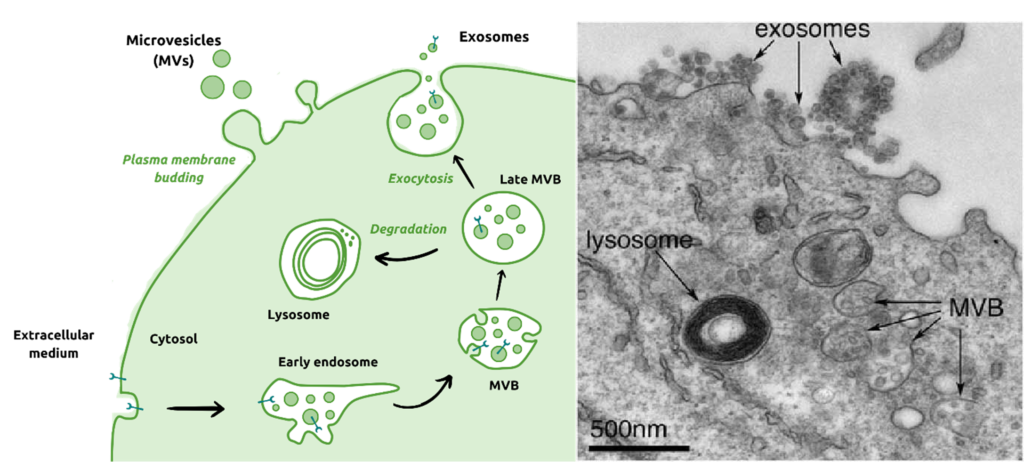
Biogenesis of exosomes and microvesicles. Left - adapted from Kowal et al., 2014; right - exosome-secreting cancer cell, Edgar et al., 2016. MVB: multi-vesicular bodies
Diverse, context-dependent biological functions
For a long time, exosomes and MVs were seen as a means for cells to eliminate excess and/or non-functional cellular components. Since then, extensive research has highlighted their role in a wide range of biological processes: cell maintenance (recycling of cell surface proteins and signaling molecules), cell-cell communication, angiogenesis, antigen presentation, coagulation, cell homeostasis, inflammation, etc.
Thanks to their ability to transport and transfer a wide variety of active cargoes and deliver them to another cell, whether nearby or far away, extracellular vesicles are capable of modifying the functions of the receiving cell, and thus impacting numerous biological processes. Exosomes have been isolated from a variety of body fluids, including blood, saliva, plasma, urine, sperm and cerebrospinal fluid. The cell “receiving” the exosomes will interact with them by endocytosis, membrane fusion or ligand/receptor interaction, resulting either in internalization of their contents, or the triggering of signaling cascades, for example.
This impact on biological processes is at play in healthy cells, but also in the context of numerous pathologies such as cancer, neurodegenerative diseases, infections or autoimmune diseases.
Medical applications
The potential of VEs and exosomes as biomarkers
Exosomes and VEs are produced by cells in both healthy and pathological conditions. They contain proteins, lipids, metabolites and nucleic acids that reflect the physiological state of their cell of origin, making them a source of biomarkers for clinical diagnosis. In the literature, several biomarkers typical of pathologies have been isolated from exosomes: for Parkinson’s disease, for example, alpha synuclein has been isolated from plasma exosomes. What’s more, EVs are present in many bodily fluids: they can therefore be collected non-invasively by liquid biopsy.
In oncology, diagnosis via exosomal markers could enable early detection of genetic or phenotypic alterations, thanks in particular to the nucleic acids contained in the vesicles. This diagnostic approach therefore has a number of advantages over the conventional method of tissue biopsy, which is invasive and biased by tumor heterogeneity. In addition to early diagnosis, exosomes are also of interest for the development of personalized treatments, prognosis and overall treatment monitoring.
The potential of exosomes as therapeutic tools
Two main approaches are used in products currently under development: the use of EVs as vectors, for targeted drug delivery, and the use of purified cell-derived EVs as “active ingredients”.
Exosomes as vectors
In this approach, exosomes can be loaded with a variety of therapeutic cargoes depending on treatment needs. Exosomes can be modified or functionalized to specifically target certain cells or tissues in the body, improving treatment efficacy and precision. As “natural transporters“, exosomes offer considerable advantages: they have low immunogenicity and toxicity, protect their cargo from degradation, and are able to cross the cytoplasmic membrane and the blood-brain barrier. This approach could reduce undesirable side-effects, improve treatment efficacy and reach specific tissues.
Cell-derived EVs as therapy
With this strategy, EVs, often exosomes, are collected from the culture medium of specific cells: often stem cells (mesenchymal, neural, etc.) but also cancer cells, platelets, immune cells, etc.
Cell-derived exosomes can be used as therapeutic products in their own right, without the addition of specific cargo. Indeed, exosomes “inherit” therapeutic effects similar to those of their parent cells: exosomes derived from mesenchymal stem cells, for example, have great potential in regenerative medicine. This “cell-free” alternative to stem cell treatments could offer several advantages, such as lower immunogenicity and toxicity, easier access, better preservation, and the absence of tumorigenic potential.
Exosomal therapies, or the use of exosomes as vectors, are widely investigated approaches in oncology, with numerous projects in development for the treatment of cancers.
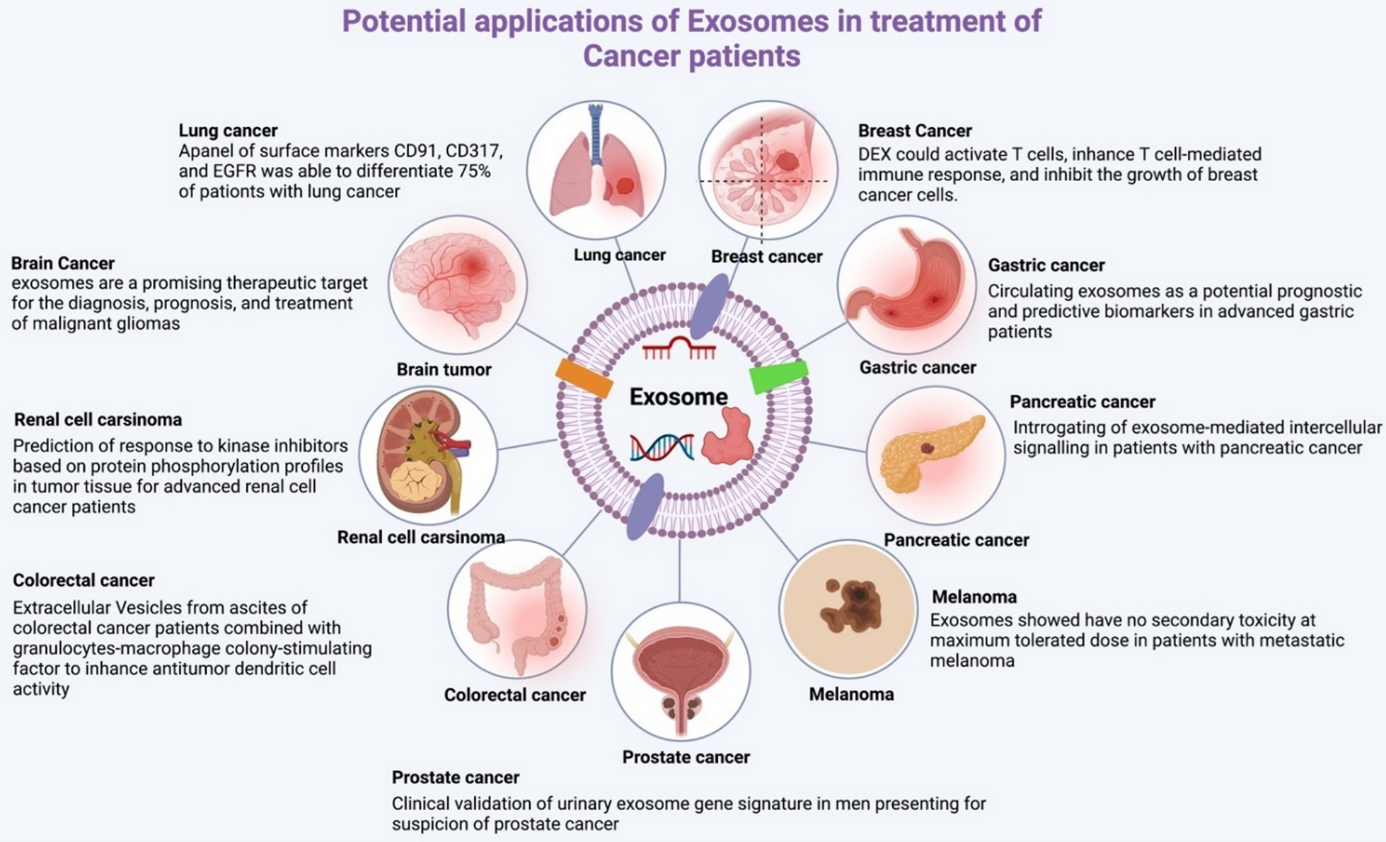
Potential applications of exosomes in cancer; Hussen, B.M et al., 2022
Challenges
Despite the density of research into extracellular vesicles and exosomes, and the rapid growth of the sector, there are still a number of technical and other challenges to overcome.
Purification and characterization
Isolation and purification techniques are still suboptimal and not very standardized. Isolating exosomes is difficult because some components of biological fluids such as lipoproteins or other VEs have sizes that overlap with those of exosomes (30-150 nm).
Added to these difficulties is the complexity of characterization: in-depth analysis of EV characteristics is often hampered by the heterogeneity of isolates, resulting in a mixed size distribution, and difficulties in profiling vesicle contents.
These issues raise questions about exosome bioproduction , in terms of reproducibility, safety and cost. Guidelines and standards need to be defined, in compliance with biopharmaceutical regulations, to enable exosomes to be used in the clinic.
Dispensing, dosing and pharmacokinetics
A major challenge for the future development of EVs is to control their routing to target sites and maintain their efficiency. To achieve this goal, several issues need to be addressed: the frequency of treatment needed to maintain their effect (dosage, half-life of exosomes in tissues, etc.) and the side-effects of treatment, particularly in the long term. A better understanding of the biology of EVs and exosomes, and in particular of cargo encapsulation mechanisms, is needed to optimize these steps.
Analysis of the market for exosomes and extracellular vesicles
Pipeline
As the field of exosomes and intracellular vesicles is relatively recent, there are currently no products on the market. Nevertheless, given the promising prospects as a diagnostic tool, therapeutic tool or technological platform, enthusiasm for these approaches is high, resulting in a rich global pipeline with 420 unique products in development.
The majority of products in the pipeline are exosomes (59%), or extracellular vesicles (23%). The latter refer to all vesicles of eukaryotic origin that are not exosomes. Microbial vesicles, such as bacteria’s outer-membrane vesicles (OMVs) or viruses’ virus-like vesicles (VLVs), also account for a significant proportion of the pipeline (17%). These projects have been removed from the rest of the analysis to focus on the analysis of the exosome and intracellular vesicle pipeline, i.e. 347 unique products.
Pipeline per type
Pipeline per phase
*products under development excluding OMVs and VLVs
Projects in the pipeline are mainly in the early stages(discovery or pre-clinical), with only 11% in the clinical phase. As the pipeline is quite rich, this corresponds to 40 projects involving EVs or exosomes currently in clinical trials. The five countries with the most products in development are the USA, South Korea, the UK, China and Australia. The USA and South Korea are far ahead, together accounting for 219 unique products in development, or 63% of the pipeline.
Pipeline by country
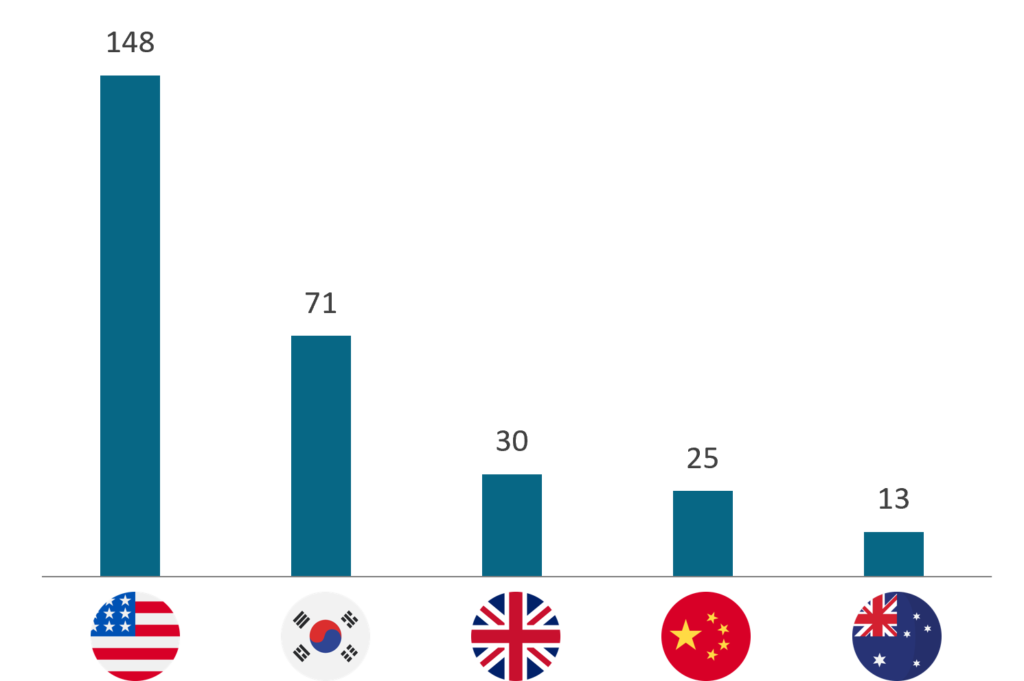
Pipeline by therapeutic area
In terms of therapeutic areas, applications are quite varied, as illustrated by the top 10 by number of products in development. The first three targeted indications are oncology, neurology and infectious diseases.
Among the most advanced projects is ExoFlo™, developed by Direct Biologics. It is a product containing growth factors and extracellular vesicles, notably exosomes, isolated from mesenchymal stem cells. The candidate is currently in Phase III clinical trials, notably for the treatment of moderate to severe acute respiratory distress syndrome, post-acute sequelae of COVID-19, transplant rejection and refractory Crohn’s disease. Diasome pharmaceuticals has also begun a Phase III clinical trial for its hepatocyte-targeted vesicle technology (HDV platform), aimed at the targeted delivery of insulin in the treatment of type 2 diabetes.
Trends & key players
The exosome market is still very new, and is growing year by year with products in development, particularly in clinical applications. This upward trend is illustrated in particular by the number of clinical trials underway bearing the tag ” exosomal therapy “, which has been on the rise overall since 2017.
The hype surrounding exosomes and EVs is also reflected in the large number of players on the market, as well as in some major deals. Examples include Evox Therapeutics2020 deals, first with Takeda for a partnership focused on rare diseases worth over $800 million, then a partnership worth over 1 $B with Eli Lilly, for the treatment of neurological diseases. Both deals concern the development of therapies using Evox Therapeutics exosome-based technology platform.
There have also been a number of fund-raising events for biotechs developing exosomes. Most recently, EXO Biologics raised $16 million to further develop therapies based on extracellular vesicles derived from mesenchymal stem cells.
Clinical trials*
*tagged “exosomal therapy”.
Players
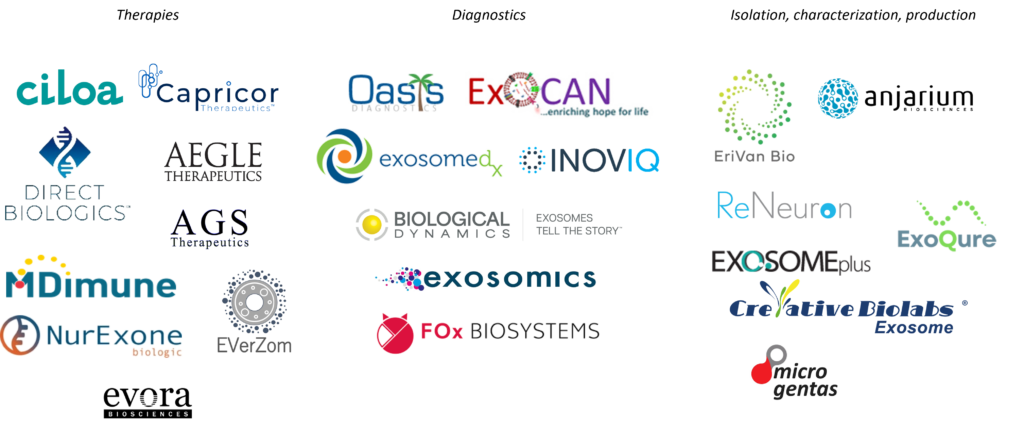
Conclusion
Exosomes represent an innovative and promising modality for regenerative medicine and diagnostics. Their ability to act as natural therapeutic vectors, their potential for early disease diagnosis and their role in regulating biological processes offer vast opportunities for medical applications. Ongoing research efforts have brought projects to the clinical stage, and continue to lead to technical and medical innovations that have the potential to improve the treatment and management of numerous pathologies.

This article is an extract from our Immunowatch “Exosomes & Other Extracellular vesicles” published in July 2024. You can download it in full at :
Immunowatch – Edition 9 – Exosomes & Other extracellular Vesicles
Our other watches are available on the dedicated page :
If you’re looking for support for your projects involving exosomes and extracellular vesicles, don’t hesitate to explore our our range of servicesand contact us for further information.
We’d be delighted to use our expertise to help you achieve your goals!
Sources
- GlobalData April 2024
- Di Bella, M. A. (2022). Overview and Update on Extracellular Vesicles: Considerations on Exosomes and Their Application in Modern Medicine. Biology, 11(6), 804. https://doi.org/10.3390/biology11060804
- Doyle, L. M., & Wang, M. Z. (2019). Overview of Extracellular Vesicles, Their Origin, Composition, Purpose, and Methods for Exosome Isolation and Analysis. Cells, 8(7), 727. https://doi.org/10.3390/cells8070727
- Edgar, J. R. (2016). Q&A : What are exosomes, exactly? BMC Biology, 14(1), 46. https://doi.org/10.1186/s12915-016-0268-z
- Gao, M., Gao, W., Papadimitriou, J. M., Zhang, C., Gao, J., & Zheng, M. (2018). Exosomes-The enigmatic regulators of bone homeostasis. Bone Research, 6(1), 1-13. https://doi.org/10.1038/s41413-018-0039-2
- Hussen, B. M., Faraj, G. S. H., Rasul, M. F., Hidayat, H. J., Salihi, A., Baniahmad, A., Taheri, M., & Ghafouri-Frad, S. (2022). Strategies to overcome the main challenges of the use of exosomes as drug carrier for cancer therapy. Cancer Cell International, 22(1), 323. https://doi.org/10.1186/s12935-022-02743-3
- Kowal, J., Tkach, M., & Théry, C. (2014). Biogenesis and secretion of exosomes. Current Opinion in Cell Biology, 29, 116-125. https://doi.org/10.1016/j.ceb.2014.05.004
- Mosquera-Heredia, M. I., Morales, L. C., Vidal, O. M., Barceló, E., Silvera-Redondo, C., Vélez, J. I., & Garavito-Galofre, P. (2021). Exosomes: Potential Disease Biomarkers and New Therapeutic Targets. Biomedicines, 9(8), 1061. https://doi.org/10.3390/biomedicines9081061
- Muthu, S., Bapat, A., Jain, R., Jeyaraman, N., & Jeyaraman, M. (2021). Exosomal therapy-A new frontier in regenerative medicine. Stem Cell Investigation, 8, 7. https://doi.org/10.21037/sci-2020-037
- Tan, F., Li, X., Wang, Z., Li, J., Shahzad, K., & Zheng, J. (2024). Clinical applications of stem cell-derived exosomes. Signal Transduction and Targeted Therapy, 9(1), 1-31. https://doi.org/10.1038/s41392-023-01704-0
- Wang, X., Tian, L., Lu, J., & Ng, I. O.-L. (2022). Exosomes and cancer-Diagnostic and prognostic biomarkers and therapeutic vehicle. Oncogenesis, 11(1), 1-12. https://doi.org/10.1038/s41389-022-00431-5
- https://www.labiotech.eu/trends-news/evox-therapeutics-eli-lilly/
- https://bioinformant.com/exosomes

